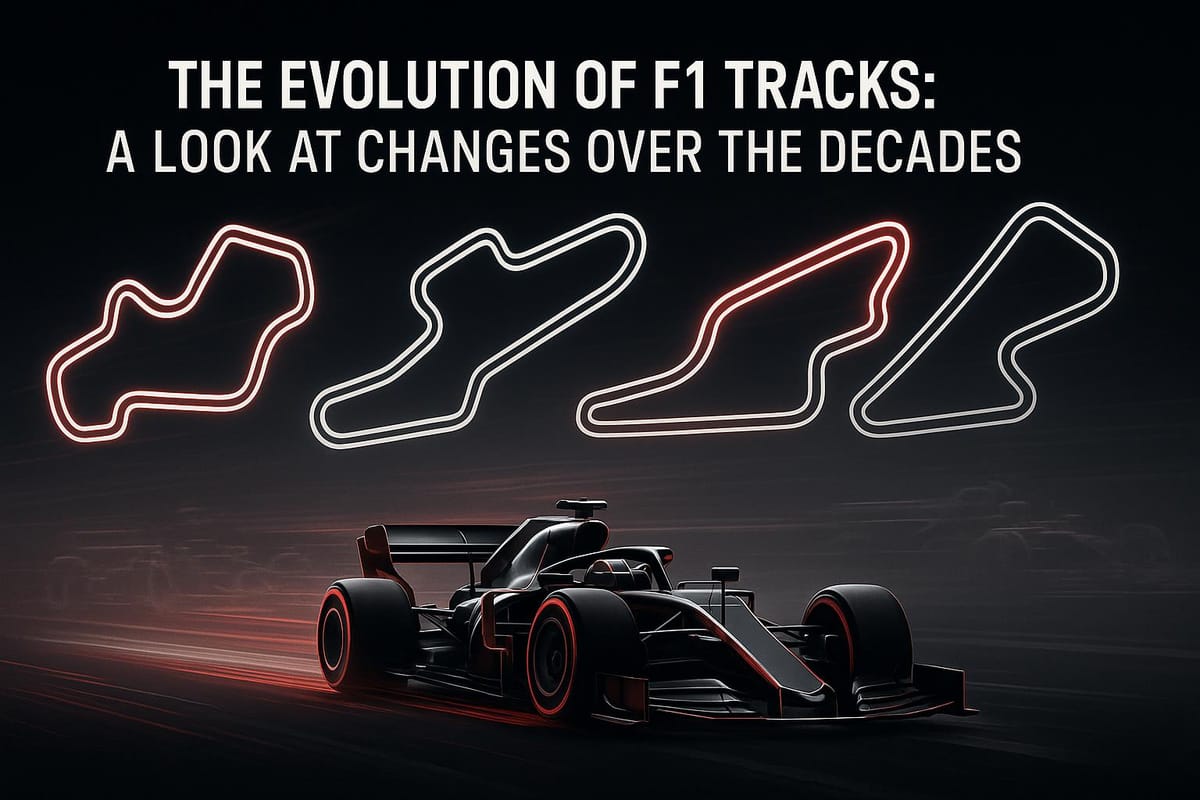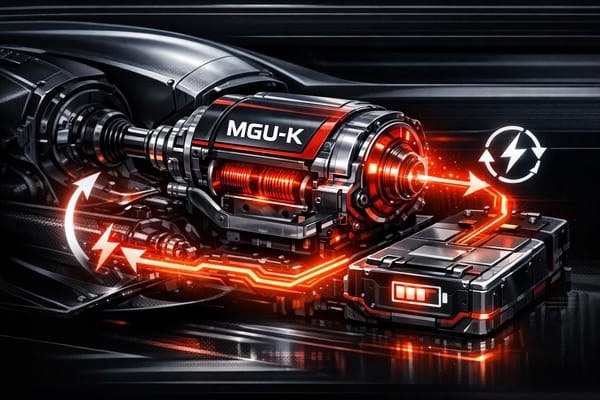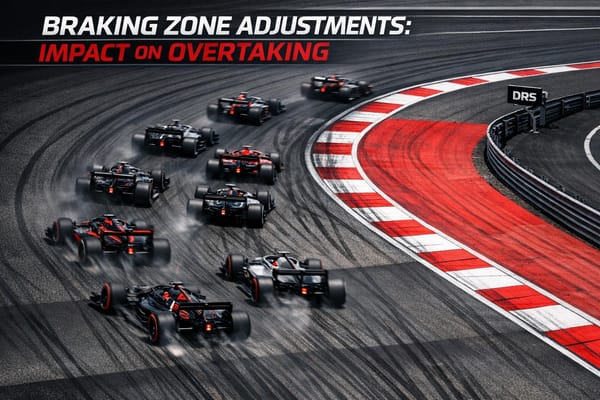The Evolution of F1 Tracks: A Look at Changes Over the Decades
Explore the evolution of F1 tracks, showcasing advancements in safety, technology, and sustainability over decades of motorsport history.

Formula 1 tracks have transformed significantly over the past 70 years. Early circuits were dangerous public roads with minimal safety features, while today’s tracks prioritize driver protection, advanced technology, and fan experiences. Key changes include:
- Safety Improvements: Modern tracks feature TecPro barriers, asphalt run-off areas, and the Halo device, reducing fatal incidents.
- Track Design Evolution: Early layouts focused on speed with long straights and minimal safety. Iconic tracks like Spa and Monza have been redesigned to balance speed and safety.
- Technology Integration: Tracks now use advanced materials, data analysis, and precise engineering to enhance performance and safety.
- Sustainability Goals: New circuits incorporate renewable energy and eco-friendly practices, aligning with F1's carbon-neutral goals by 2030.
- Fan-Centric Upgrades: Venues now offer immersive experiences, karting, museums, and hospitality centers, making them year-round destinations.
These changes reflect F1's commitment to safety, innovation, and creating a better experience for drivers and fans alike.
The Evolution of Imola: From Fast and Dangerous to Modern F1 Track
Early Formula One Track Development
The early days of Formula One racing paint a vivid picture of daring drivers navigating circuits that would be unimaginable for today’s high-speed motorsport. When the championship kicked off in 1950, purpose-built tracks were rare, and most races unfolded on public roads - never intended to host the blistering speeds of race cars.
From Public Roads to Dedicated Race Tracks
In its infancy, Formula One relied heavily on public roads temporarily closed for racing. These street circuits were fraught with hazards that modern drivers would find hard to fathom. The tracks twisted through forests and countryside, with spectators often standing alarmingly close to the action. Barriers were rudimentary - or nonexistent - leaving trees, buildings, and cliffs as the only obstacles between drivers and disaster.
The shift to dedicated race tracks marked a turning point, with venues like Monza and Silverstone leading the charge. Silverstone, for instance, began as a repurposed aerodrome in 1950, with the circuit tracing the airfield's perimeter road. Over time, it evolved into a 3.66-mile track equipped with cutting-edge facilities - an evolution that would astonish the drivers of Formula One's early years.
Unlike the chaotic public road circuits, permanent tracks offered a controlled environment and the chance to introduce basic safety measures. However, early designs prioritized speed above all else, often at the expense of driver safety.
Early Track Design Features
In the early years, the pursuit of speed overshadowed any serious consideration for safety. Driver safety was barely a concern during Formula One's first decade, and the risks were accepted as part of the sport. Death was seen as an unfortunate but inevitable price for the thrill of racing. Remarkably, the average age of competitors in the inaugural 1950 British Grand Prix was 39, reflecting an era where experience mattered more than youth.
Tracks of the time were characterized by long, straight sections designed to push cars to their limits. But safety infrastructure was rudimentary at best. Straw bales served as barriers, run-off areas were rare, and medical support at the track was minimal.
The grim reality of the sport’s danger is reflected in the statistics. Between 1954 and 1994, 27 Formula One drivers lost their lives during races, practice sessions, or qualifying events, with fatalities peaking in the 1960s. During that decade, one driver was killed in approximately every eight races.
Legendary driver Jackie Stewart, a three-time world champion, famously described the perilous odds:
"In my period of driving, there was only a one in three chance that I was going to live. There was a two out of three chance that I was going to die".
Davis Sims, a Lotus mechanic from 1962 to 1972, offered a chilling perspective on how drivers were viewed at the time:
"There were too many drivers getting killed then, and they'd soon sign another one up, you know, pretty quickly. I mean it was. Expandable? Nearly.".
Similarly, Jacky Ickx, who raced from 1966 to 1979, highlighted the role of chance in survival:
"To survive, in that time, it wasn't a question of talent, it was purely a question of luck.".
The combination of inadequate barriers, basic protective equipment, and unforgiving circuits created a deadly environment. These harsh realities eventually catalyzed the safety revolution that reshaped Formula One into the sport we recognize today.
Major Circuit Changes: 3 Famous Examples
The evolution of Formula One’s most iconic circuits is a testament to how the sport has transitioned from perilous layouts to modern tracks that balance speed with improved safety. Tracks like Spa-Francorchamps, Monza, and Silverstone stand as prime examples of this transformation, showcasing how safety measures and design updates have reshaped both the sport's competitive nature and its iconic venues.
Spa-Francorchamps: Turning Danger Into Design

Spa-Francorchamps is arguably the most striking example of how a circuit can evolve without losing its soul. Known for its breathtaking scenery and equally terrifying dangers, the track earned a reputation for being one of the most hazardous in F1 history. Jackie Oliver once remarked:
"If you went off the road, you didn't know what you were going to hit"
Meanwhile, Jackie Stewart called the infamous Masta Kink:
"By far the most difficult corner in the world"
In 1979, Spa underwent a dramatic overhaul, reducing its length from 14.1 km to 6.947 km (about 4.3 miles) and removing its most perilous sections. The redesign introduced the now-iconic Eau Rouge/Raidillon complex, which remains a fan and driver favorite. More recently, an €80 million upgrade announced in October 2020 brought modern safety features, including gravel traps and expanded run-off areas, with the project completed in March 2022. Reflecting on the challenge of Eau Rouge, Fernando Alonso noted:
"You come into the corner downhill, have a sudden change [of direction] at the bottom and then go very steep uphill. From the cockpit, you cannot see the exit and as you come over the crest, you don't know where you will land"
Monza: Balancing Speed and Safety

Monza, known as the "Temple of Speed", has managed to retain its high-speed legacy while adapting to modern safety standards. When it opened in 1922, the circuit combined a 5.5 km (3.4 miles) road course with a 4.5 km (2.8 miles) steeply banked oval. However, early tragedies, such as the 1928 accident that claimed Emilio Materassi and 27 spectators, as well as the 1933 Grand Prix that killed three drivers, led to ongoing changes.
After the fatal 1961 crash involving Wolfgang von Trips and 15 spectators, Formula One permanently retired the oval. In 1972, two chicanes were added to temper the track's speeds. Further updates followed the 1994 tragedies at Imola, with larger gravel traps introduced to the circuit's long curves. Most recently, a $21 million resurfacing project in 2024 modernized the track’s infrastructure. Despite all these updates, Monza remains a high-speed circuit, with drivers spending nearly 75% of a lap at full throttle. Formula 1 CEO Stefano Domenicali praised the upgrades, stating:
"The recent upgrades to the circuit's infrastructure and the planned investment show a strong commitment to the long-term future of Formula 1 in Italy"
However, not everyone is thrilled with the changes. Daniel Ricciardo expressed his feelings, saying:
"Part of Monza is that it was old-school, and now that's gone. The resurfacing looks great, the asphalt looks really nice, but the kerbs, I'm a bit disappointed in"
Silverstone: Honoring History While Moving Forward

Silverstone’s journey from an old Royal Air Force base to a premier Formula One venue reflects how a historic track can evolve while staying true to its roots. Since hosting the first Formula 1 World Championship race on May 13, 1950, Silverstone has undergone numerous layout changes. Today, its 5.891 km (3.66 miles) configuration is celebrated as one of the fastest circuits in F1.
Recent updates have maintained Silverstone’s connection to its heritage, with corners and straights renamed to honor its aviation history and British motorsport culture. The circuit remains a formidable challenge, as Lewis Hamilton described in 2018:
"A flat-out lap around Silverstone feels like flying a fighter jet"
These iconic circuits demonstrate Formula One’s ability to adapt, ensuring safety and progress while preserving the essence of what makes each track unique.
How Safety and Technology Changed Track Design
Formula One circuits have undergone a dramatic transformation, evolving from perilous tracks into venues designed with safety at their core. Today’s circuits emphasize driver protection through cutting-edge barriers, advanced technology, and rigorous regulatory standards. Let’s take a closer look at how safety features, technological advancements, and stricter rules have reshaped track design.
New Safety Features at F1 Circuits
Modern F1 tracks are virtually unrecognizable compared to their earlier counterparts, especially in terms of safety infrastructure. One of the most notable upgrades is the widespread use of TecPro barriers, constructed from polyethylene and foam. These barriers have largely replaced traditional steel Armco systems, offering better energy absorption during high-speed crashes.
Perhaps the most iconic safety innovation of recent years is the Halo device, a titanium structure capable of withstanding an immense load - equivalent to the weight of a 12-ton London double-decker bus. Its life-saving potential was on full display during the 2020 Bahrain Grand Prix when Romain Grosjean’s car split in half in a fiery crash. Reflecting on the incident, Grosjean remarked:
"I wasn't for the halo some years ago, but I think it's the greatest thing that we've brought to Formula 1, and without it I wouldn't be able to speak with you today."
Run-off areas have also become standard at modern circuits, often featuring gravel traps or asphalt zones to decelerate cars before they reach barriers. Additionally, curbs lining the track have been redesigned to reduce the risk of cars going airborne if they run wide.
Technology Improvements and Track Infrastructure
Beyond physical safety measures, technology plays a pivotal role in making F1 circuits safer. The FIA employs advanced software to determine the optimal placement of barriers, ensuring maximum protection for both drivers and spectators. High-speed cameras, capable of capturing 400 frames per second, and on-board data recorders provide critical information that feeds into the FIA’s safety database.
F1 cars are now equipped with accident data recorders, which capture details like speed and impact forces during crashes. Additionally, accelerometers embedded in drivers' earpieces measure head movement during impacts, offering valuable insights into crash dynamics. Driver-facing cameras and extra accelerometers further enhance real-time data collection, enabling race officials to make quick safety decisions while also informing future improvements.
FIA Safety Rules and Track Requirements

The FIA’s approach to safety has evolved significantly since the 1960s, a time when fatal accidents were tragically common - occurring in one out of every eight races. Founded in 1904, the FIA has continuously tightened safety regulations in response to major incidents. For example, Niki Lauda’s near-fatal crash at the Nürburgring in 1976 led to the circuit being dropped from the F1 calendar.
The introduction of the Halo device in 2018 underscores how FIA regulations drive innovation. Made from aerospace-grade titanium, the Halo can withstand a vertical load of 116 kN. According to FIA estimates, it has increased driver survival rates by at least 17%. Jackie Stewart, a vocal advocate for safety reforms, once noted:
"My quest for safety had become by far the most unpopular thing that I was faced with. I don't think there's a single corner of any race track in the world called Stewart corner."
Regulations also adapt to specific incidents. Following Grosjean’s crash, several changes were made to the Bahrain track, including the addition of two tire walls with conveyor belt covers, extending the tire barrier at turn nine, and removing a curve between turns eight and nine to lower the risk of cars becoming airborne.
This dynamic approach ensures that F1 circuits meet stringent safety standards, with continuous updates made as new risks emerge or better solutions are developed.
Track Changes for Modern F1 Cars
Modern Formula 1 cars, equipped with ground effect aerodynamics, generate immense downforce but are more sensitive to uneven track surfaces. To adapt to these demands, track engineers prioritize creating and maintaining high-quality, consistently smooth surfaces. These updates not only enhance racing competitiveness but also align with stricter safety standards.
Ground Effect Cars and Track Design
Ground effect technology requires exceptionally uniform track surfaces because even small irregularities can compromise aerodynamic performance. To address this, engineers focus heavily on refining track preparation to strike a balance between peak performance and safety. This focus has also driven advancements in tire technology and track material composition.
Tire Development and Track Surfaces
The introduction of slick tires revolutionized track design, as these tires significantly reduced lap times - by over 2 seconds per lap. This innovation pushed designers to rework asphalt compositions to optimize tire grip. F1 track surfaces are crafted from asphalt, a mix of bitumen binder and aggregates like stones and gravel, which plays a crucial role in determining tire performance and durability. For new circuits, specific types of stones are even imported to ensure the highest surface quality.
Engineers evaluate track texture by analyzing both macro roughness (overall smoothness) and micro roughness (the finer texture of the stones). Over time, "rubber deposition" from tires increases grip, a phenomenon known as track evolution. However, resurfacing a track can drastically alter its grip levels, as seen during the 2020 Turkish Grand Prix, where drivers struggled with low grip on the newly laid asphalt.
Pirelli has observed that freshly resurfaced tracks, especially those with black-tinted asphalt, can elevate track temperatures to as high as 122°F at Monza. This heat directly impacts tire performance. Simone Berra, Pirelli's chief F1 engineer, highlighted the challenges:
"The adhesive grip is quite high, so the tarmac is grippy, but, on the other hand, the tarmac is very smooth. The mechanical grip of the tyre is not that high. That [imbalance] is why we are generating this level of graining. The adhesive grip is okay, but the hysteresis grip is not high."
Faster Cars Need Bigger Run-Off Areas
With F1 cars reaching ever-higher speeds, circuits have expanded their run-off areas to improve safety. Modern tracks now feature extensive run-off zones, replacing older gravel traps and concrete barriers. These zones allow cars to slow down more gradually and reduce the severity of impacts, lessening the forces drivers experience during crashes.
The importance of these design changes is evident when comparing incidents. Max Verstappen's crash at Silverstone resulted in a 51G impact, whereas Mick Schumacher's crash in Jeddah registered a lower 33G impact due to a softer collision angle and limited run-off space. Besides enhancing safety, larger run-off areas also influence race dynamics by giving drivers more room for error during overtakes and aggressive maneuvers, subtly shaping race strategies and driving behavior.
Future F1 Track Development
Formula 1 circuits are entering a new era, combining decades of safety and technological progress with a bold vision for the future. With a goal of achieving net-zero carbon emissions by 2030, these tracks are being reimagined to blend environmental responsibility with enhanced fan experiences. The result? Venues that go beyond racing to become all-encompassing entertainment hubs.
Environmental Considerations in Circuit Design
Sustainability is reshaping how F1 tracks are built and operated. Future circuits are incorporating renewable energy sources like solar panels and wind turbines directly into their designs. In fact, by 2023, 75% of F1 promoters powered their events with renewable energy, a jump from 50% in 2022.
A standout example is the Las Vegas Grand Prix, which aims to set a new standard for environmentally conscious racing. This event is working toward becoming the first net-zero water consumption sporting event, thanks to innovative water-efficient cooling systems that saved 200,000 gallons of water during its inaugural year. The track also utilized Honeywell Titan® polymer in its asphalt, improving both durability and sustainability.
"Southern Nevada continues to be a world leader in water conservation and efficiency. Through this partnership, we are not only helping offset water use for the Las Vegas Grand Prix event, but also establishing a water-saving precedent for future large-scale events in our community." - David Johnson, SNWA Deputy General Manager
The Grand Prix Plaza in Las Vegas earned LEED Silver® certification for its new construction. Its location near the Las Vegas Strip encourages sustainable transportation options, and the facility incorporates green initiatives like site management and eco-friendly cleaning practices.
Looking ahead, F1 circuits are focusing on eco-friendly construction materials to lower their carbon footprints and adopting waste reduction programs that eliminate single-use plastics and expand recycling efforts. While sustainability is a key priority, these circuits are also investing heavily in creating unforgettable fan experiences.
Better Fan Facilities and Experiences
Modern F1 circuits are transforming into year-round entertainment destinations, offering much more than just race-day excitement. These venues are evolving into lifestyle hubs, complete with live music stages, nightclubs, museums, hotels, and even business conference facilities.
The Las Vegas Grand Prix showcases this trend with North America's largest immersive F1 fan experience, featuring over 100,000 square feet of entertainment space. The Grand Prix Plaza boasts three major attractions: F1® X (a 4D interactive exhibition), F1® DRIVE (karting on part of the actual Strip Circuit), and F1® HUB (a space with F1 simulators, a flagship store, and elevated dining options).
"Grand Prix Plaza represents a significant investment in the future of Formula 1 in Las Vegas... These new attractions will offer unprecedented access to F1, giving many fans their first up-close look at a Formula 1 car before stepping into a racing simulator or even karting on a portion of the Las Vegas Strip Circuit." - Emily Prazer, President and CEO of Las Vegas Grand Prix, Inc.
Other circuits are following suit. The Canadian Grand Prix introduced two-story hospitality centers, quadrupling the available space for teams, while relocating team parking to more convenient locations behind the Turn 1 grandstands. Meanwhile, Hungary's Hungaroring is undergoing its most ambitious redevelopment yet, transforming into the country's largest event venue and sports facility. These upgrades include a complete overhaul of the paddock, main building, and grandstands.
New Circuits and Layout Concepts
The next generation of F1 circuits is being designed with a focus on multi-functional motorsport venues located near urban centers. These new layouts aim to integrate seamlessly into communities, offering year-round accessibility and diverse uses.
A prime example is the Qiddiya Speed Park Track in Saudi Arabia, designed by Tilke Engineers & Architects. This circuit will be part of a larger sports and entertainment complex near Riyadh and is expected to join the F1 calendar in the coming years.
"It's not only pure track and grandstands for people but it's entertainment." - Hermann Tilke, Leading Designer
Modern circuit design also prioritizes the digital viewing experience, ensuring that tracks are optimized for compelling camera angles and visually stunning backdrops for television and social media. With millions of fans watching remotely, the visual appeal of a race is just as important as the on-site experience.
Take the Miami Grand Prix, for instance. Its event space covered 160 acres, featuring hospitality structures, retail facilities, and garages, while requiring 32 megawatts of backup power - enough to supply 26,000 homes. Cooling systems provided 2,768 tons of power, capable of cooling 900 homes.
Circuit designer Alexander Wurz sums up the vision for the future:
"I'm convinced modern racetracks will become lifestyle centres . . . [fitting] perfectly into the urban environment"
These advancements mark a shift in how F1 circuits are conceived, moving away from standalone racing venues to integrated entertainment destinations. By balancing environmental goals with innovative designs and fan-focused amenities, Formula 1 is redefining what it means to experience motorsport in the 21st century.
Conclusion: F1 Tracks Continue to Change
F1 circuits have come a long way, evolving from the perilous public roads of the 1950s into the cutting-edge venues we see today. This transformation reflects the sport's dedication to advancing technology, improving safety, and enhancing the fan experience.
Safety has been a driving force behind these changes. The FIA’s focus on reducing risks has reshaped track design in fundamental ways. For instance, computer analysis flagged 27 high-risk corners across circuits, leading to safety upgrades on 15 of them. Modern innovations like Tecpro barriers and asphalt run-off areas have proven highly effective, with studies showing that asphalt can slow cars twice as efficiently as gravel or grass. However, these improvements haven’t come without debate - some argue that expansive run-off zones make racing less thrilling and raise questions around track limits.
Historic tracks face their own set of challenges as they try to balance their storied legacies with modern standards. Zandvoort, for example, made a successful return to the F1 calendar by incorporating gravel run-off areas while preserving its unique character.
Beyond safety, environmental priorities are shaping the future of F1 circuits. With the sport aiming to cut carbon emissions by at least 50% compared to 2018 levels, sustainability has taken center stage. The Bahrain International Circuit, for example, generated 5.28 MW of clean energy from its solar farm between the 2022 and 2023 Grands Prix - enough to power the entire event. Similarly, over 75% of race promoters used renewable energy in 2023, a significant jump from 50% the previous year.
"Sustainability is one of the most important factors to us not only as a sport, but as a business. It is no longer enough for us to simply deliver great action and wheel-to-wheel racing on the track, we need to ensure that we are doing so in a sustainable way so our sport can thrive long into the future." – Stefano Domenicali, President & CEO, Formula 1
Technology continues to play a pivotal role in shaping modern circuits. Features like advanced drainage systems, electronic warning systems, and comprehensive weather contingency plans are now standard. Regular FIA inspections and strict certifications ensure tracks meet the latest safety and operational standards. Additionally, F1 circuits are evolving into year-round hubs for their communities, offering more than just race-day excitement.
As the sport tackles challenges like adapting to ground effect cars and pursuing carbon neutrality, F1 tracks will continue to evolve. This ongoing transformation showcases F1’s ability to honor its rich history while pushing toward a forward-thinking future. Safety, innovation, and sustainability will remain at the heart of this progress, ensuring that F1 circuits stay as dynamic as the sport itself.
FAQs
How have safety innovations like the Halo and TecPro barriers improved F1 track safety and design?
Safety advancements, such as the Halo device and TecPro barriers, have transformed the way F1 tracks are designed, prioritizing driver protection without compromising the excitement of the sport.
The Halo, a robust titanium structure encircling the cockpit, has become a game-changer for driver safety. Capable of withstanding forces up to 12 tons, it provides critical protection against head injuries, especially in scenarios where cars flip over. This innovation has set a new benchmark for cockpit safety in motorsport.
Meanwhile, TecPro barriers have redefined crash protection on the track. Made from energy-absorbing materials, these barriers can reduce crash impact forces by approximately 40%, significantly enhancing safety in high-speed sections of the circuit. These developments have led to redesigns of F1 tracks, incorporating stronger protective barriers and improved crash zones, underscoring the sport's dedication to safeguarding drivers while preserving the adrenaline-pumping nature of racing.
How is sustainability shaping the design and operations of Formula 1 circuits?
Sustainability in Formula 1
Formula 1 is steering toward a greener future, with a bold goal of reaching net zero carbon emissions by 2030. To make this happen, race tracks are embracing eco-friendly initiatives like adopting sustainable fuels, boosting energy efficiency, and ramping up recycling efforts. Take the Circuit de Barcelona-Catalunya, for example - it’s rolled out specific programs aimed at reducing its environmental footprint. Meanwhile, the Las Vegas Grand Prix has been recognized for its environmentally conscious construction methods.
Beyond the tracks, F1 is introducing low-carbon energy solutions and better water management strategies at its events. These steps reflect the sport’s drive to minimize its environmental impact while keeping the adrenaline-pumping action and innovation fans expect.
How do F1 circuits combine high-speed thrills with top-notch safety for drivers and fans?
Modern Formula 1 tracks are meticulously designed to combine thrilling speed with top-tier safety, following stringent FIA regulations aimed at safeguarding both drivers and fans. These circuits are equipped with spacious run-off areas, impact-absorbing barriers like Tecpro and tire walls, and cutting-edge safety measures such as the halo device, which has played a pivotal role in preventing severe injuries.
By constantly refining track layouts and integrating advanced safety technologies, these circuits adapt to the sport's ever-increasing pace and technological advancements. This careful balance allows drivers to push their performance boundaries while ensuring a safer environment for all.
Related posts
- Imola’s Resurrection: From Tragedy to Triumph at the Emilia Romagna Grand Prix Circuit
- Albert Park Uncovered: The History, Evolution, and Challenges of the Australian Grand Prix Circuit
- How F1 Tracks are Designed: The Art and Science Behind the Curves
- Behind the Scenes: What Makes F1 Tracks Unique and Unforgettable




